Do-it-yourself waterproofing in the bathroom: a comparative overview of materials + installation instruction
In the bathroom, the degree of humidity is constantly increased. This has to be taken for granted and abandoned useless attempts to fight "with the elements." The only thing that can and should be done is to neutralize as much as possible the negative impact of moisture on building structures and materials.
To do this, waterproof the bathroom, the use of which is mandatory for all bathrooms. We will tell you how hydroprotection is performed, and list what materials are used to form a reliable water barrier. To help independent home masters, the article provides detailed instructions.
The content of the article:
Is it possible to do without waterproofing?
It may seem that arranging insulation in the bathroom is an waste of effort and money. Proponents of this point of view motivate the position by the fact that the ceramic tiles, which most often decorate bathrooms, are completely waterproof.
This is true, but tile joints pass moisture well, as do cracks and chips on the tile itself. Even if these cracks are microscopic.
Do not be sure of the quality of plumbing fixtures. Sooner or later, malfunctions may appear in them, and water will flood the floor or, even worse, will gradually accumulate under the equipment, gradually destroying the floor covering or wall.
That is why plumbers and builders insistently recommend the arrangement of high-quality waterproofing of the bathroom. What is meant by this?
First of all, you need to insulate the floor. This is done so that water cannot penetrate the floor slab and seep into the apartment or basement below. And also so that moisture does not accumulate in the base, does not destroy it and does not provoke the growth of mold and fungus.
The ideal waterproofing of the floor looks like a kind of "trough" made of special material. It is applied to the bathroom floor with partial access to the walls. The height of this approach is about 20-25 cm. The insulating "trough" should be completely waterproof. But that is far from all.
The walls of the bathroom also need insulation, even if they are tiled. As already mentioned, inter-tile seams and cracks perfectly pass moisture, which will drain over the surface of the wall and accumulate in the most inappropriate places.
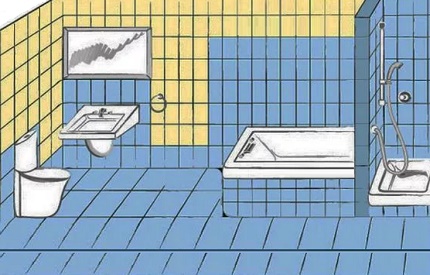
To prevent this unpleasant phenomenon, it is worth equipping waterproofing protection in the most “dangerous” areas. They are located in close proximity to sinksbaths shower boxes and other plumbing equipment.
In some cases, experts recommend waterproofing the ceiling of the bathroom. This is necessary if the bathroom is in a multi-storey building and there are still apartments above it.
A brief overview of the main types of materials
In construction stores, the range of insulation materials is very, very wide. All of them can be divided into several main types, each of which we will take a closer look at.
Roll type insulation
This is a large group of roll insulation, which includes materials with a variety of properties. Initially, the basis for them was cardboard, on which several layers of bitumen-containing compositions were applied.
They provided water resistance of the material. Such coatings include roofing material, glassine, and the like. Their main disadvantage is the relatively short life.
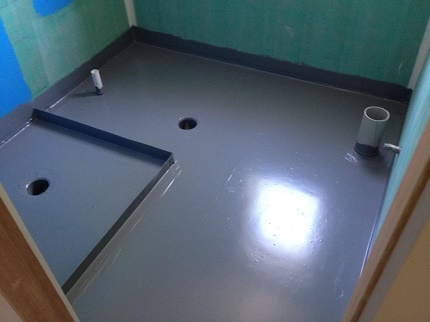
Later, fiberglass or fiberglass was chosen as the basis for insulation. This significantly increased the service life, but slightly complicated the installation of materials. Since during the installation process such coatings may crack.
Roll insulation can be mounted in different ways:
- Mount. This option is used less often than others. Its essence lies in the fact that the panel is fixed on the insulated base with self-tapping screws with plastic telescopic devices in the form of fungi with wide hats. For installation, the base is first drilled, which is very laborious and not reliable enough.
- Fusion. In this case, special equipment is used: building hair dryers or gas burners. With their help, the workers melt the bottom layer of the coating, and then lay it in the right place. A laborious and rather dangerous method that is not recommended for use indoors.
- By sticking. The material is glued onto a previously prepared base. The adhesive can be applied to the substrate or, which is much more convenient, is already on the insulating coating. Most manufacturers produce the so-called self-adhesive insulation, for the installation of which it is enough to remove the protective film from the back of the adhesive.
Of all the methods described, sticking is considered the simplest. It is possible that fusion gives the highest quality laid insulation, but only specialists can competently perform such laying.
When heated, the panel becomes very elastic and easily tears. It is also important to prevent overheating of the coating, otherwise it will melt and become unusable. In addition, the volatile compounds distributed by bitumen are very toxic. Working with him indoors is dangerous.
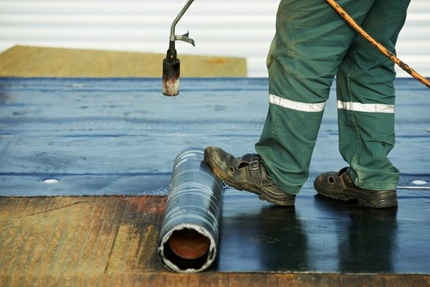
The advantages of gluing insulation are quite a lot. After laying, it forms a plastic sheet that allows the base to “breathe”.
For this reason, such materials are widely used for insulation of wooden floors and protection device. bathrooms in a wooden house. The elastic material calmly transfers all movements of natural wood and at the same time maintains its integrity. In addition, the insulation layer of rolled materials is very well supported on the base.
Another significant plus is a quick readiness for subsequent work. Foam insulation does not need time to dry, almost immediately after installation, you can proceed to the following technological operations. The cost of such materials, which is also important, is very low.
Of the shortcomings, the main one is the complexity of installation. Even self-adhesive material is quite difficult to lay correctly, given that before installation it will be necessary to carefully prepare the base.
Coating Insulating Materials
Coating compositions can be considered the very first products used as protection against water. Initially, these were vegetable and animal oils and fats, which smeared the protected surfaces.
Over time, their composition has changed radically, but the principle of application has been preserved. Modern coating materials are available in a variety of forms. These are mastics, various pastes or dry mixes.

The latter must be diluted before application in a compatible polymer emulsion or in pure water. The manufacturer will necessarily attach to their products instructions for preparing the working mixture, which is not recommended to be deviated from.
The composition of dry mixes is diverse, respectively, and the properties of the insulating material vary. For pastes and mastics, preparation for application is not required. The compositions go on sale in hermetically sealed containers. However, unlike dry mixes, their shelf life is rather limited.
This should be known, and do not purchase material "for future use". The main characteristic of coating waterproofing is its consistency. The opacity of the material depends on this, which affects the number of layers applied, the properties and scope of the coating.
Liquid solutions are applied in a layer about a millimeter thick. It is clear that at least three to four such layers will be required to obtain high-quality insulation. Important note.
When applying the liquid, each subsequent layer is applied in the direction perpendicular to the previous one. The only way to achieve the absence of possible gaps on the surface. To apply a liquid solution, take a brush, preferably a wide one, or a mackerel.
Pastes or mastics are more dense. It is impossible to lay them with a brush, for such coatings a notched trowel is used. The height of the insulation layer applied in this way is usually about 3 mm.
This makes it possible to reduce the number of layers, it will be enough two, maximum three. When laying mastic or paste, it is quite acceptable and even desirable to reinforce the surface with a special mesh.
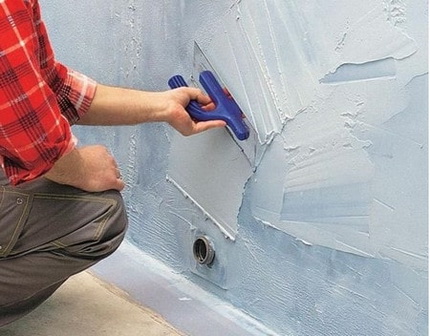
The cloth is placed between two layers of coating. A significant drawback of coating pastes and mastics is considered to be a sufficiently long coating hardening time.
Given that each subsequent layer of material can be laid only after the previous one has hardened, the process of applying waterproofing is significantly delayed. In rare cases, the manufacturer permits a third insulating layer to be applied to the second non-dried layer. This point needs to be clarified in the instructions.
Protective Impregnating Compounds
Impregnation is one of the latest advances in insulation. The compositions have a completely different principle of action from others.They do not cover the base with a protective layer, but react with it. The compositions penetrate into the porous base to a depth of 120 mm, after which they solidify, forming needle crystals.
The base of each such crystal is rotated in the direction of the expected flow of water. Thus, each of the pores of the surface is as if sealed with a solution. In this case, the base acquires a new monolithic structure, which does not peel, does not crumble and does not crack.
Impregnation is very easy to apply. They are applied to the base with a regular brush. The composition has a liquid consistency, is applied in a thin layer, so it does not affect the height of the room at all.

The manufacturer produces impregnations, which may include not only active substances, but also cement mixtures or sand. In any case, they should be applied exclusively to a damp base. This is the main condition that the impregnation penetrates deep into the coating.
The main disadvantage of impregnating materials is their limited scope. They "work" perfectly on concrete substrates, gypsum and lime plasters, FSB with low water resistance. However, they are completely powerless on brick and cement plasters.
An absolute contraindication for the use of impregnation mixtures is 3 and higher group of crack resistance of the base. Before buying, it is important to clarify the possibility of using the composition you like on an existing basis. Another disadvantage is the high cost of such insulating materials.
Questions about choosing a waterproofing for your bathroom
This is a rather complicated question that cannot be answered unequivocally. The choice of insulation type depends on many factors. First of all, this is the material of the floors. If it is a tree, it is advisable to use tapestry insulation. Any type is suitable for concrete.
It is also important to understand how serious repairs are planned. If there is an opportunity and a desire to perform the highest quality waterproofing, it is better to choose an adhesive, laid under the screed, followed by treatment with coating compounds.
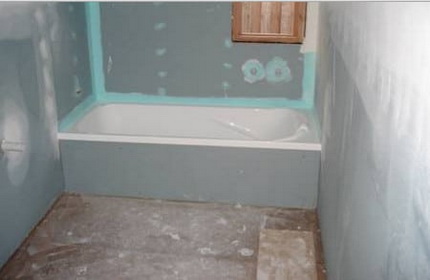
Such a tandem will provide guaranteed protection against any leaks for more than one decade. However, this is the most time-consuming option. If a relatively small repair is planned, only waterproofing waterproofing can be installed.
It is worth considering the number of storeys of the building. If the bathroom is located on the first floor of a private house, insulation of the floor and walls is enough. For high-rise buildings, you will also need work on the ceiling.
When choosing a material, it is also important to consider the possibility of changing the height of the room. If this is extremely undesirable or impossible, it is worth using impregnating or liquid coating insulation. To work with the floor, any of the existing types of materials can be selected.
It is worth considering the configuration of the room. The rolled sheet will be extremely difficult to lay in a complex bathtub. For walls and ceilings, only impregnating and coating compounds are used.
Methodology for insulating work
There are many options for how to properly make waterproofing in the bathroom with your own hands. We will consider the main points, without which it is impossible to get high-quality coverage.
We carry out preparatory work
After the material for insulation is selected, you can begin to prepare the base. The most difficult work lies on the floor. Especially if it is planned to lay an adhesive overlay under the screed.
We start by cleaning the base. If repairs are being made in an already used bathroom, you will have to completely dismantle and take out all the equipment, remove the flooring and remove the old screed.
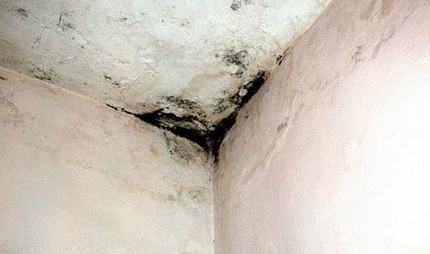
The latter is the most laborious, but necessary. As a rule, the old screed is not in the best condition. It is most likely contaminated, cracked and crumbled.
You can, of course, use it as a base for gluing insulation, but then you have to put a new screed directly on the old one. This will be an extra significant load on the floors, in addition, the floor will rise, which is extremely undesirable for the bathroom.
According to the rules, the floor in the bathroom should be lower than in any other rooms, which is additional protection in the event of a “flood”. The old screed is disassembled using special tools: a perforator, angle grinder or concrete hammer. After removing all the debris, an audit is made of the opened base.
All irregularities, chips and cracks close up and overwrite. Dust is removed and then treated with a special fungicidal composition. This is necessary to prevent the appearance of fungus. Next is the priming. It is best to apply two to three layers of a suitable primer.
Work is carried out with the obligatory capture of the lower part of the walls. Primed about 30 cm up from the level of the base. It is advisable to smooth the corners between the floor and the wall a little, so it will be easier to lay the insulating panel.
Features of laying roll insulation
For carrying out work inside the building, it is optimal to choose self-adhesive insulation. With one that fits on glue, it will be more difficult to work. First, the material is cut. It is cut into panels, the length of which includes overlaps on the walls.
In addition, you need to remember about overlaps, which must be present when laying a roll coating. Their average value is 10 cm. If this is not so, the manufacturer indicates this in the instructions.
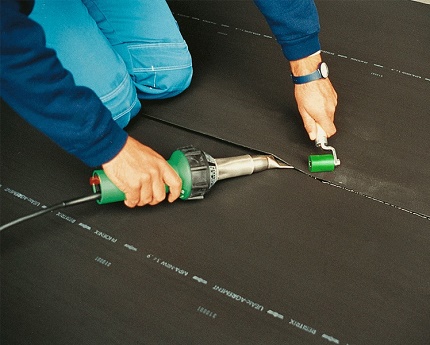
We roll out the panels on the bathroom floor and leave them until the next day so that the material is leveled. Now you can start laying. From the upper edge of the panel we retreat the distance corresponding to the size of the approach to the wall and put the coating on the base.
Gently pry off and remove the protective film from the edge of the sheet, while pressing the insulation in the floor at the same time. We do everything slowly, carefully. For a better pressing of the panel we use a roller. After the first panel is laid, you can stack the second, without forgetting about the necessary overlap.
Important note. During cutting and subsequent installation, it must be borne in mind that the joint of two paintings should not fall on the section of the interface between the wall and the floor. Otherwise, there will inevitably leak over time, and the tightness of the insulation will be broken.
Particular attention is paid to utilities. To remove pipes in the insulating panel, holes are cut out. In order for the insulation to “sit” tightly, their diameter should be less than that of pipes.
All joints of the plates and the edges of the resulting waterproof "trough" are thoroughly greased with bitumen mastic and once again with effort we roll the entire coating with a roller. If the canvas does not stretch well, you can slightly warm it with a construction hairdryer.
Coating Insulation Technique
Coating type insulation is very easy to apply. If the work will be carried out using a dry mixture, first you need to accurately prepare the working solution according to the instructions.
It should be remembered that after a relatively short time, it will harden and become unusable. Therefore, the material is bred in small portions. If you plan to use already prepared coverage, you only need to open the jar.
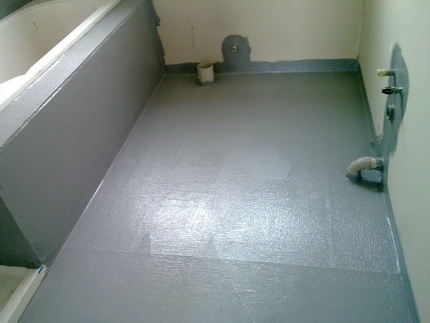
Prepared base, which can be the floor and side wall bath screen, slightly moisten to improve adhesion of materials, and then proceed to the application of the solution. It is advisable to move strictly in one direction, when applying the second layer, the composition is laid in perpendicular to the first direction.
Do not forget that the first layer must completely dry before laying the second. All corners and joints are additionally pasted with a special waterproofing tape.
It is placed in raw mastic and is pressed into the material with effort. Before applying the last layer on the base, a reinforcing mesh can be laid, which is then covered with a continuous layer of mastic.
The composition is allowed to dry completely and harden. At this time, you need to protect it from possible dust and debris. Even small particles of dirt will spoil the quality of the finished coating.
Conclusions and useful video on the topic
Video # 1. How to waterproof a bathroom with coating materials:
Video # 2. What is penetrating waterproofing:
Video # 3. How to work with glued insulating materials:
The bathroom, like no other, needs well-made waterproofing. High humidity and water leaks are extremely dangerous for building materials and finishing coatings. In addition, there is always a risk of an emergency, as a result of which flooding of someone else’s apartment or own basement may occur.
Only the right choice of material and its high-quality installation for a long time will save you from all the problems associated with excess moisture.
Want to talk about how you did waterproofing in a bathroom or a separate bathroom with your own hands? Do you know the methods and techniques that allow you to quickly apply a protective layer to building structures? Please write comments in the block below, ask questions, publish photos on the topic of the article.

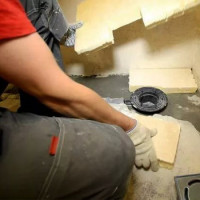 How to arrange a shower drain in the bathroom floor: step-by-step installation instructions
How to arrange a shower drain in the bathroom floor: step-by-step installation instructions 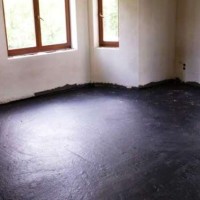 Waterproofing the floor in the apartment: features of the choice of insulation materials + work procedure
Waterproofing the floor in the apartment: features of the choice of insulation materials + work procedure 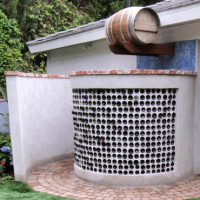 Do-it-yourself summer shower: step-by-step construction instructions
Do-it-yourself summer shower: step-by-step construction instructions 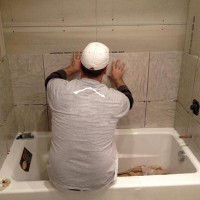 Waterproofing a bathroom under a tile: what is better to use under a tile
Waterproofing a bathroom under a tile: what is better to use under a tile 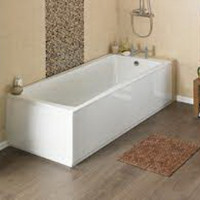 Which bath is better - acrylic or steel? Comparative review
Which bath is better - acrylic or steel? Comparative review 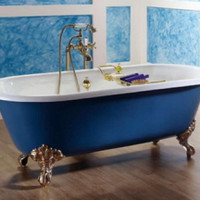 Acrylic or cast-iron bath - which is better? Comparative review
Acrylic or cast-iron bath - which is better? Comparative review  How much does it cost to connect gas to a private house: the price of organizing gas supply
How much does it cost to connect gas to a private house: the price of organizing gas supply  The best washing machines with dryer: model rating and customer tips
The best washing machines with dryer: model rating and customer tips  What is the color temperature of light and the nuances of choosing the temperature of the lamps to suit your needs
What is the color temperature of light and the nuances of choosing the temperature of the lamps to suit your needs  Replacement of a geyser in an apartment: replacement paperwork + basic norms and requirements
Replacement of a geyser in an apartment: replacement paperwork + basic norms and requirements
Making repairs, before laying tiles in the bathroom, I applied an emulsion called Flechendicht to the screed. Previously, bitumen was part of the emulsion, now it is not. The emulsion was applied three times. Each layer dried over three hours. But before the emulsion he still primed the screed. The primer was applied once, with a thickness of less than 1 ml. The primer dried out for 2 days.